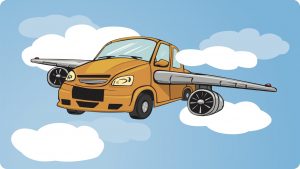Innovating The Innovations
Mashup thinking is an excellent way to develop new ideas and products. Rather than thinking outside the box (always difficult), you select ideas from multiple boxes and mash them together. Sometimes, nothing special happens. Sometimes, you get a genius idea.
Let’s mash up self-driving vehicles and drones to see what we get. First, let’s look at the current paradigms:
Self-driving vehicles (SDVs) include cars and trucks equipped with special sensors that can use existing public roadways to navigate autonomously to a given destination. The vehicles navigate a two-dimensional surface and should be able to get humans or packages from Point A to Point B more safely than human-driven vehicles. Individuals may not buy SDVs the way we have traditionally bought cars and trucks. We may simply call them when needed. Though the technology is rapidly improving, the legal and ethical systems still require a great deal of work.
Drones navigate three-dimensional space and are not autonomous. Rather, specially trained pilots fly them remotely. (They are often referred to as Remotely Piloted Aircraft or RPAs). They military uses drones for several missions, including surveillance, intelligence gathering, and to attack ground targets. To date, we haven’t heard of drones attacking airborne targets, but it’s certainly possible. Increasingly, businesses are considering drones for package delivery. The general paradigm is that a small drone will pick up a package from a warehouse (perhaps an airborne warehouse) and deliver it to a home or office or to troops in the field.
So, what do we get if we mash up self-driving vehicles and drones?
The first idea that comes to mind is an autonomous drone. Navigating 3D space is actually simpler than navigating 2D space – you can fly over or under an approaching object. (As a result, train traffic controllers have a more difficult job than air traffic controllers). Why would we want self-flying drones? Conceivably they would be more efficient, less costly, and safer than the human-driven equivalents. They also have a lot more space to operate in and don’t require a lot of asphalt.
We could also change the paradigm for what drones carry. Today, we think of them as carrying packages. Why not people, just like SDVs? It shouldn’t be terribly hard to design a drone that could comfortably carry a couple from their house to the theater and back. We’ll be able to whip out our smart phones, call Uber or Lyft, and have a drone pick us up. (I hope Lyft has trademarked the term Air Lyft).
What else? How about combining self-flying drones with self-driving vehicles? Today’s paradigm for drone deliveries is that an individual drone goes to a warehouse, picks up a package, and delivers it to an individual address. Even if the warehouse is airborne and mobile, that’s horribly inefficient. Instead, let’s try this: a self-driving truck picks up hundreds of packages to be delivered along a given route. The truck also has dozens of drones on it. As the truck passes near an address, a drone picks up the right package, and flies it to the doorstep. We could only do this, of course, if drones are autonomous. The task is too complicated for a human operator.
I could go on … but let’s also investigate the knock-on effects. If what I’ve described comes to pass, what else will happen? Here are some challenges that will probably come up:
- If drones can carry people as well as packages, we’ll need fewer roadways. What will we do with obsolete roads? We’ll probably need fewer airports, too. What will we do with them?
- If people no longer buy personal vehicles but call transportation on demand:
- We’ll need far fewer parking lots. How can cities use the space to revitalize themselves?
- Automobile companies will implode. How do we retrain automobile executives and workers?
- We’ll burn far less fossil fuel. This will be good for the environment but bad for, say, oil companies and oil workers. How do we share the burden?
- If combined vehicles – drones and SDVs – deliver packages, millions of warehouse workers and drivers will lose their jobs. Again, how do we share the burden?
- If autonomous drones can attack airborne targets, do we really need expensive, human-piloted fighter jets?
These are intriguing predictions as well as troublesome challenges. But the thought process for generating these ideas is quite simple – you simply mash up good ideas from multiple boxes. You, too, can predict the future.
Luck, Skill, and Clembama
In last year’s NCAA football championship game, Alabama beat Clemson by a score of 45 to 40.
In this year’s NCAA football championship game, Clemson beat Alabama by a score of 35 to 31.
The aggregate score is 76 to 75 in favor of Alabama.
So, which team is more skilled?
To ponder the question, we need to return to Michael Mauboussin’s ideas* about skill and luck – and, especially, his concept of the paradox of skill.
Let’s start with definitions for skill and luck. For Mauboussin, a key question helps us identify skill: Can I lose on purpose? If the answer is yes, then some skill must be involved in the process, whether you’re shooting hoops or playing poker. If the answer is no, then the process is random – it’s a matter of luck.
Most processes – like NCAA football games – involve both skill and luck. How can we sort out the differences between the two? Was Alabama more skilled last year or just luckier? What about Clemson this year?
Mauboussin’s paradox of skill can help us sort this out. Simply put, the paradox states that: “In activities that involve some luck, the improvement of skill makes luck more important…” We have training programs that can improve skills in many competitive activities, including sports, business performance, combat, and perhaps, even investing. As more people take advantage of these programs and average skill levels improve, you might think that luck would become less important in determining outcomes.
Mauboussin says that exactly the opposite is true. The big issue is skill differential and distribution. If a given skill is unevenly distributed in a society, then skill likely determines the outcome. Luck doesn’t have a chance to worm its way in. On the other hand, if skill is broadly and evenly distributed, then even minor fluctuations in luck can change the outcome.
As an example, Mauboussin cites the difference between the winning time and the time for the 20th finisher in the men’s Olympic marathon. In 1932, the difference was 39 minutes. In 2012, it was 7.5 minutes. Clearly, the skill of marathon running has become more evenly distributed over the past 80 years. We have more people with greater skills more evenly distributed than we had in the past. As a result, the marathon has become much more competitive.
Paradoxically, as the marathon has become more competitive, luck plays a greater role. Let’s say that the 1932 winner had the bad luck of stepping in a pothole at Mile 22 and had to limp to the finish line. Because he had so much more skill than the other runners, he might still have won the race. If the 2012 winner stepped in the same pothole, chances are the other (highly skilled) runners would have caught and passed him. He would have lost because of bad luck.
The paradox of skill should teach us some humility and helps to illuminate the illusion of control. We may think we’re successful because we’re skilled and talented and can control the events around us. But oftentimes – especially when skill is evenly distributed – it’s nothing more than an illusion. It’s just plain luck.
And what about Clemson and Alabama? My interpretation is that both teams are perfectly balanced in terms of skills. So the outcome depends almost entirely on luck: a lucky bounce, a stray breeze, a bad call, a slippery turf, and so on. Let’s celebrate two great teams that have separated themselves from the pack but not from each other. Perhaps we should call them Clembama.
* I used several sources for Mauboussin’s ideas. His 2012 book, The Success Equation, is here. In 2012, he also gave a very succinct presentation to the CFA Institute. That paper is here. His HBR article from 2011 is here. In 2014, he gave a lecture as part of the Authors at Google series – you can find the video here. And David Hurst’s very enlightening review of Mauboussin’s book is here.
Will Corruption Skyrocket In Sweden?
Here’s a pair of questions raised by Dan Ariely in his book, Predictably Irrational:
Your school age daughter calls you at work and asks you to bring home a red pencil she needs for her homework.
Q1: You find a red pencil in your company’s supply closet. Would you take it home or would you consider that cheating?
Q2: You can’t find any red pencils in the office but you know you can buy one for a quarter at the office supply store around the corner. You don’t have a quarter but you can find one in the petty cash drawer by the coffee machine. Would you take a quarter and buy your daughter a red pencil or would you consider that cheating?
If you’re like Dan Ariely or me or most people, you think it’s OK to take a pencil from the supply closet but you would never take a quarter from the petty cash drawer.
The value involved is the same in both cases, so why do we think one scenario is OK and the other is not? According to Ariely, it’s about cash. We tend not to cheat when cash is involved. We know it’s wrong to take money. We can’t rationalize the action to ourselves.
The farther we get from cash, however, the easier it is to rationalize cheating. Most of us wouldn’t steal money from a stranger. But we might shade things a bit on our tax returns and we don’t feel too badly about inflating our losses on insurance claims. Ariely concludes that, “When we look at the world around us, much of the dishonesty we see involves cheating that is one step removed from cash.”
So does this mean that corruption is about to skyrocket in Sweden?
For the past several decades, Sweden has been moving toward a cashless society. Banks began charging for checks about 30 years ago. Rather than writing checks, people found it easier and less expensive to transfer money from one account to another, initially by fax, then online, and now by mobile devices like smartphones. ATMs are being phased out. By one estimate, only 900 of the 1,600 branch banks in the country even bother to keep cash on hand.
So how do Swedes pay for things? With blips and chips. You can pay the parking meter with your smart phone. You can transfer money from one account to another with an app called Swish. You can give money to a beggar by swiping a card or tapping a phone. Even Swedish churches use apps instead of collection plates.
The Swedish transition to a cashless society accelerated in September 2009, after the Västberga heist. Thieves in a stolen helicopter smashed through the skylight of a bank-processing center and made off with about $6.5 million in cash. The heist has been romanticized endlessly in Sweden. But its biggest impact was to erode trust in cash. If cash could be stolen so easily – and it was never recovered – why bother with cash? (I happened to walk by the Västberga center, on my way to work, about half an hour before the attack. Yikes!)
In addition to theft, cash is involved with a whole host of nefarious activities – ranging from drugs to weapons to prostitution to payments to illegal aliens. So why not do away with it? Dan Ariely’s data may give us pause – the farther we get from cash, the more likely we are to cheat.
So is Sweden growing more corrupt? At least one estimate suggests, “…cases of electronic fraud have more than doubled in the past decade….” Before giving up cash altogether, the Swedish government should take some baseline measures of corruption and cheating and then monitor them over time. It may turn out that going cashless is much more expensive than the occasional bank heist.
Unbelievable Memories
I used to think that experience plus memory produced beliefs. Now I think I may have gotten this backwards as well. (For other things I’ve gotten backwards, click here).
Here’s how I used to think memory worked:
We experience the world around us and we remember our previous experiences. By and large, our memories of previous experiences are accurate. Perhaps we lose a little detail around the edges but the main ideas are clear and constant. The combination of (accurate) memories plus current experiences leads us to conclusions about how the world works. These conclusions create mental models and, voilà, we have a belief system. Our memories create our beliefs.
As our experiences change, our belief system does, too. We’re constantly comparing our experiences to our mental models. As our experiences – both remembered and current – change, our mental models should change, too. We can be confident that our memories are accurate and that our mental models are up to date.
It’s all neat and tidy. Everything flows in a nice, straight line. It’s completely logical. Unfortunately, it’s also completely wrong.
According to Chris Chabris and Dan Simons, most people – 63% in their survey – believe that “human memory works like a video camera, accurately recording the events we see and hear so that we can review and inspect them later.” It’s a comforting thought but it’s wrong. We invent new memories with remarkable ease and mix up events and expectations
As Chabris and Simons point out, our memory “…depends both on what actually happened and how we make sense of what happened.” We may have the same experiences as other people but draw different lessons from them. But if my lessons learned are different from yours … well, whose memory is accurate? My lessons learned fit my mental models and yours fit yours. Our beliefs create our memories.
As Jorge Luis Borges pointed out, no one sees a unicorn because no one expects to see a unicorn. The same is true for memory – we remember what we expect to remember. William Brewer and James Treyens conducted a classic experiment on this. They asked subjects to wait briefly in “…what they thought was a graduate student’s office…” Shortly after, the researchers asked the students to recall what they saw in the office. The subjects reported seeing what one would expect to see in a graduate student’s office – books, file cabinets, etc. But none of that was there; the subjects simply made it up.
Our memories change to fit our beliefs, not the other way round. Chabris and Simons recount the story of the basketball coach Bobby Knight who was fired for “choking” a young college player. Knight and the player had radically different memories of the event. In fact, Knight claimed not to remember it at all. I suspect he was telling the truth. Knight had a famously bad temper and choking a student was apparently not such a big deal to him. Nothing special to remember. For the player, it was exactly the opposite. Being choked by a world-famous coach was a very big deal. In fact, the player remembered an “embellished” version of the event — even after seeing video tape of the event.
Who was lying? Probably neither the player nor Knight. Their memories simply conformed to their beliefs.
The list goes on. We don’t notice changes in our surroundings. We see a person in a black leather jacket leave the room. Moments later, we see a person in a black leather jacket make a phone call. We perceive it to be the same person and remember it that way – even if two very different people are wearing similar jackets.
We can also “borrow” memories from others. If my friend, Trevor, tells a colorful story about himself that peripherally involves me, I may change it over time by swapping the actors. Trevor becomes the peripheral character; I become the main event. Further, I’ll be absolutely confident that I’m telling the truth, the whole truth, and nothing but the truth.
What’s it all mean? We’re far too confident in our own memories. Our memories change to fit our beliefs. Eyewitnesses have no idea what really happened. Different people with different memories of the same event are all telling the truth as they see it. Nothing is as it seems. And don’t you forget it.
The Cost of Bad Writing
My students know that I’m a stickler for good writing. When they ask me why I’m so picky, my answer usually boils down to something that’s logically akin to, “Because I said so.”
I know that the ability to write effectively has helped my career. But is it really so important in today’s world of instant communications? Only if you want to save $400 billion a year.
Josh Bernoff, the owner of WOBS LLC, recently published his survey of 547 business professionals who write “at least two hours per week for work, excluding e-mail”. Bernoff’s findings make a clear and compelling case for teaching – and mastering — effective writing skills. His key findings:
- Reading and writing is a full-time job. Bernoff’s respondents – most of whom were not full-time editors or writers – spend about 25.5 hours reading and 20.4 hours writing each week.
- Though we complain about e-mail, it takes up only about a third of our reading and writing time. We spend far more time writing and reading memos, blog posts, web content, press releases, speeches, and so on.
- We think we’re pretty good; everybody else sucks. On an effectiveness scale of 1 to 10 (with 10 being totally effective), professionals rate their own writing at 6.9. They rate writing prepared by others at 5.4.
- We agree on the Big 5. A majority of respondents thought the following issues contributed most to making written content “significantly less effective”: 1) too long; 2) poorly organized; 3) unclear; 4) too much jargon; 5) not precise enough.
- We waste a lot of time. For all respondents, 81% agreed or strongly agreed with the statement “Poorly written material wastes a lot of my time”. For managers, directors, and supervisors, the figure is 84%.
- We want feedback but have a hard time getting it. Only 49% of all respondents – and 41% of managers, directors, and supervisors – agree with the statement, “I get the feedback I need to make my writing better.”
- Professionals want to write better but are constrained by jargon, passive voice, corporate bullshit and “…the number of people who still think writing is more about making them sound important …” than communicating clearly.
Bernoff rolls all the numbers together and concludes that, “…America is spending 6 percent of total wages on time wasted attempting to get meaning out of poorly written material.” The total cost? About $400 billion.
(You can find Bernoff’s white paper and infographics here. Brief summaries in the popular press also appear here and here).
Bernoff calculates the cost of wasted time. But what’s the direct cost? How much do we spend teaching our employees to write well? Bernoff doesn’t address this specifically but I found a College Board survey from 2004 that digs into the question. The survey went to 120 American companies associated with the College Board’s Business Roundtable. The result? American companies – excluding government agencies and nonprofits – spend about $3.1 billion annually “remedying deficiencies in writing”.
The College Board study also cites an April 2003 white paper titled, “The Neglected ‘R’: The Need For a Writing Revolution.” The conclusion of that study was simple: “Writing today is not a frill for the few, but an essential skill for the many.”
In 2006, The Conference Board picked up a similar theme in a report that asked a simple question: “Are They Ready To Work?” The survey asked companies about the most important skills that newly minted graduates should have. It then asked respondents to grade the skills of newly hired employees. Graduates of two- and four-year college programs were rated “deficient” in three areas: 1) Written communications, and 2) Writing in English; 3) Leadership.
Business leaders agree that writing is an important skill. We can cite studies going back more than a decade that suggest we’re doing a poor job teaching the skill. Bernoff’s study suggests we’re not doing any better today – in fact, we may be doing worse. What to do? We need to invest more time, energy, and effort teaching the “neglected R”. Or you could just hire me.




